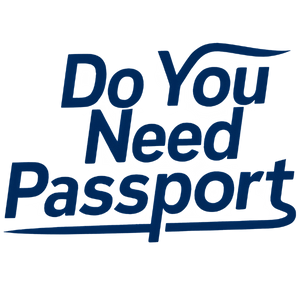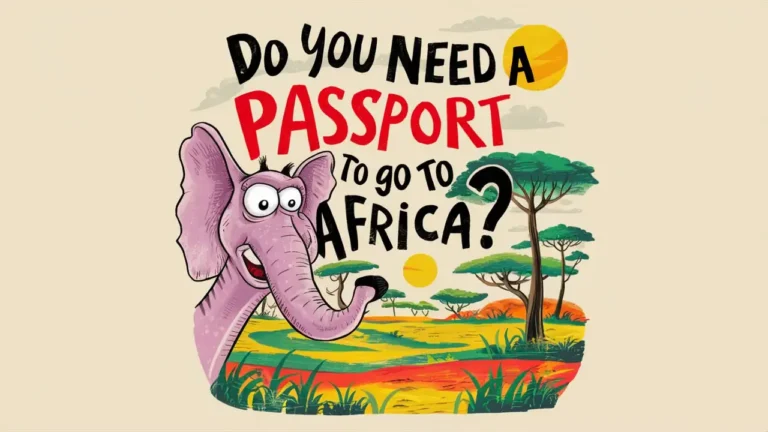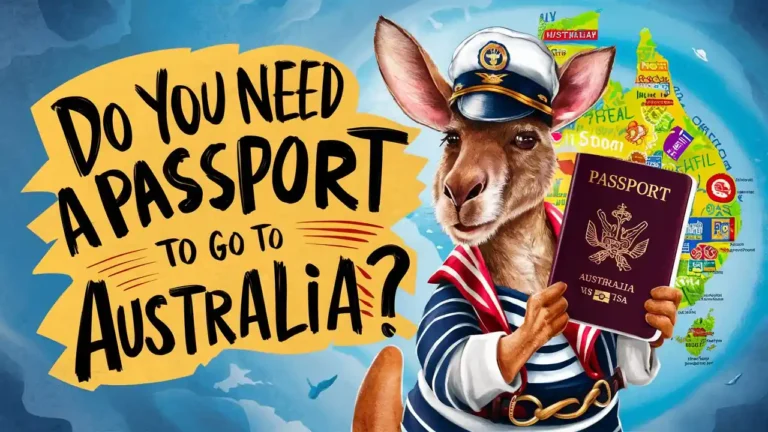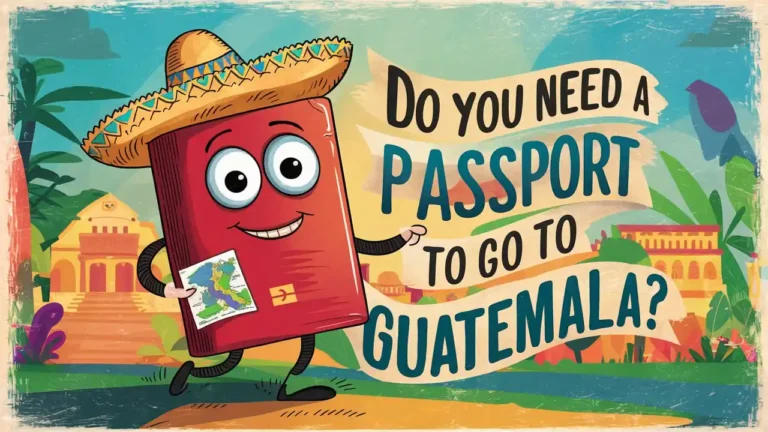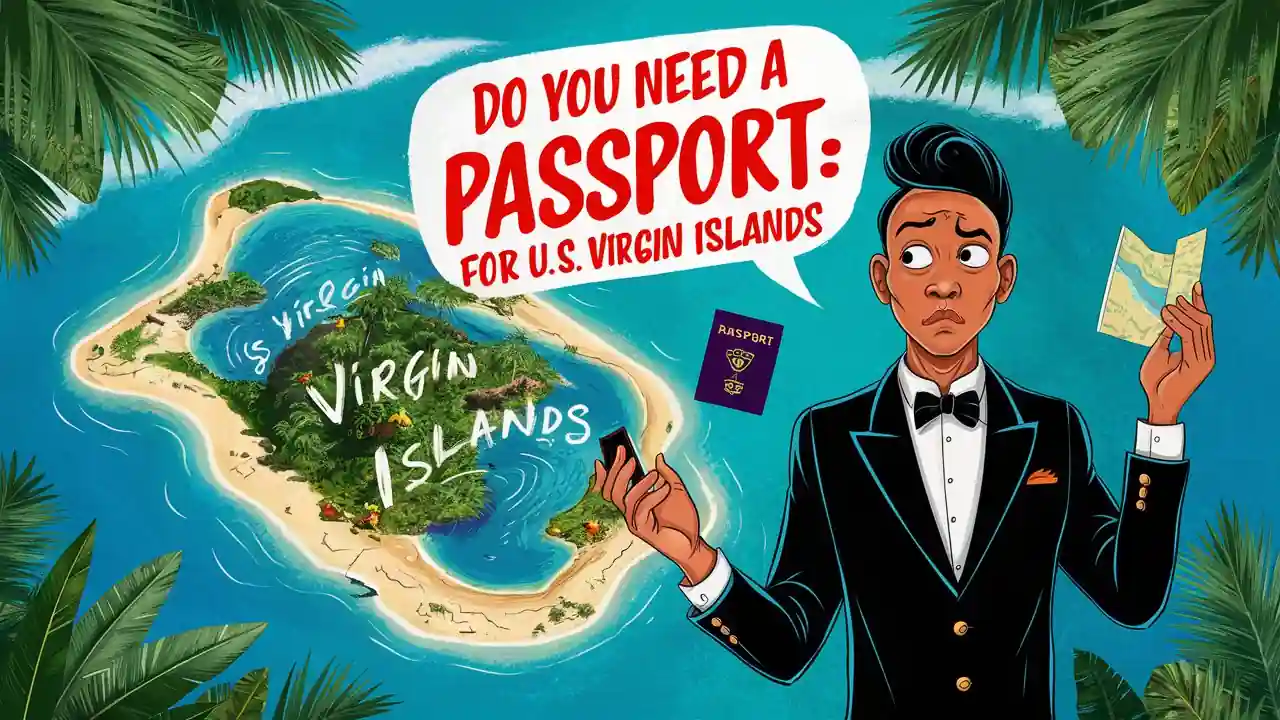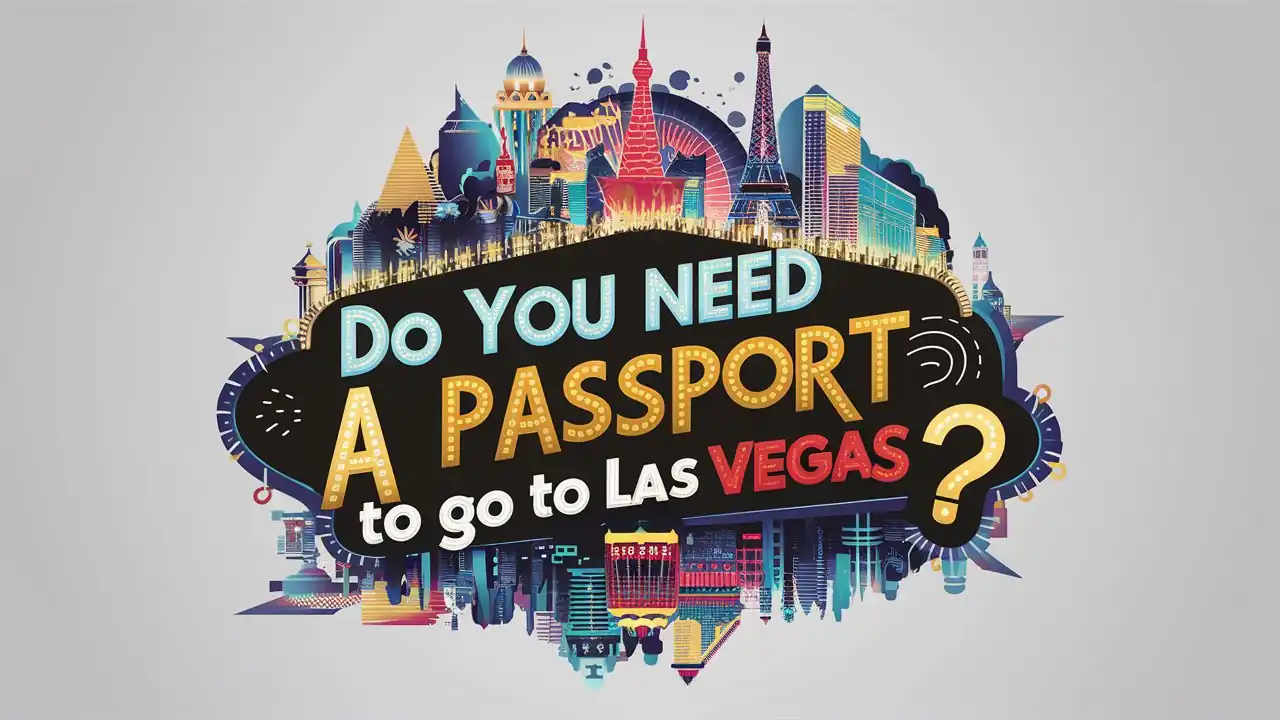Do You Need a Passport to go to Panama? (2024)
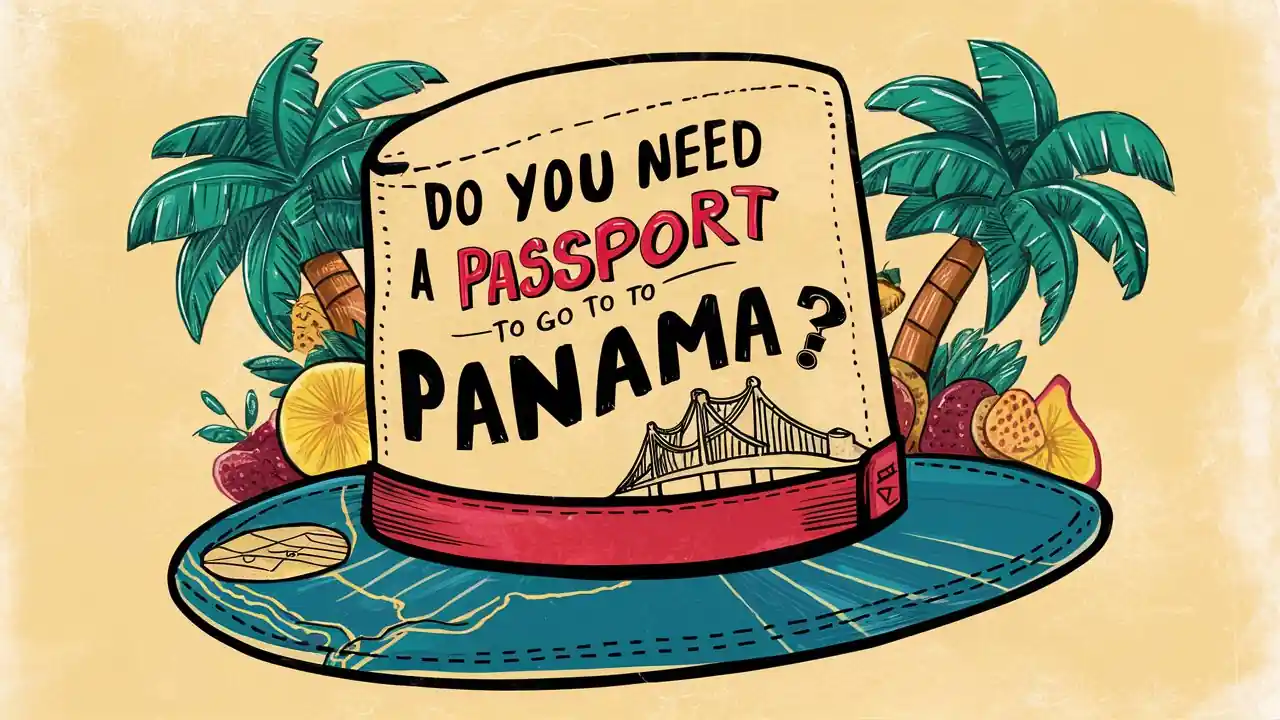
Introduction
As you plan your Panama getaway, one crucial question arises: Do you need a passport to go to Panama? Let’s start with a quick Introduction.
Planning a trip to Panama, the vibrant Central American country known for its stunning beaches, lush rainforests, and the iconic Panama Canal? One of the first questions that may come to mind is whether you need a passport to enter this tropical paradise. The short answer is yes, you do need a valid passport to travel to Panama, regardless of your country of origin. This requirement is essential for international travel and ensures that you can legally enter and exit the country.
A passport serves as your primary form of identification and is crucial for clearing immigration procedures when arriving in Panama. It’s important to note that your passport should be valid for at least six months beyond your planned stay in Panama. This six-month validity rule is a common requirement in many countries and helps ensure that your travel document remains valid throughout your trip and for a reasonable period after your return. Additionally, while a passport is the primary requirement, depending on your nationality and the purpose of your visit, you may also need to obtain a visa or a tourist card. Always check the most up-to-date entry requirements before planning your Panamanian adventure.
Do You Need a Passport for Panama?
When planning a trip to Panama, one of the most crucial questions is whether you need a passport. The answer depends on your citizenship and the purpose of your visit. Generally, most international travelers will need a valid passport to enter Panama. However, there are some exceptions and additional requirements to consider.
For U.S. Citizens:
- A valid U.S. passport is required for entry into Panama.
- The passport must be valid for at least three months beyond the planned date of departure from Panama.
- U.S. citizens do not need a visa for tourist stays of up to 180 days.
- A tourist card may be required, which can be purchased upon arrival for a small fee.
- Proof of onward travel and sufficient funds may be requested by immigration officials.
For Non-U.S. Citizens:
- Most international travelers need a valid passport to enter Panama.
- The passport should be valid for at least six months beyond the planned stay.
- Visa requirements vary depending on the country of citizenship.
- Citizens of many countries can enter visa-free for tourist stays of up to 180 days.
- Some nationalities may need to obtain a visa before travel.
- Always check with the Panamanian embassy or consulate for the most up-to-date requirements.
Traveling by Land or Sea (For U.S. Citizens):
- U.S. citizens arriving in Panama by land or sea must present a valid passport.
- The same passport validity requirements apply as for air travel.
- If entering from Costa Rica or Colombia by land, be prepared to show proof of onward travel.
Traveling by Land or Sea (For Non-U.S. Citizens):
- All non-U.S. citizens must present a valid passport when arriving in Panama by land or sea.
- Visa requirements apply as they would for air travel.
Children Under 16:
- All children, regardless of age, must have their own valid passport to enter Panama.
- There are no exceptions for minors traveling with parents or guardians.
- Visa requirements for children are the same as for adults.
Closed-Loop Cruises:
- Even for closed-loop cruises that include Panama as a port of call, passengers are required to have a valid passport to enter Panama.
- Panama’s entry requirements apply regardless of the cruise itinerary.
Who Does Not Need a Passport for Panama?
- Citizens of countries within the Central America-4 Border Control Agreement (El Salvador, Guatemala, Honduras, and Nicaragua) can enter Panama with just their national ID card for short stays.
- Some cruise ship passengers on “closed-loop” cruises (beginning and ending at the same U.S. port) may be able to enter Panama without a passport, but this is subject to change and not recommended.
For Locals:
- Panamanian citizens do not need a passport to re-enter their own country.
- They can use their Panamanian national ID card (cédula) for identification at border control.
- However, Panamanians will need a passport for international travel to other countries.
Remember that immigration policies can change, so it’s always best to check with official sources, such as the Panamanian embassy or consulate, for the most current information before planning your trip.
Do You Need a Visa to go to Panama?
Panama, a country known for its iconic canal, diverse ecosystems, and vibrant culture, attracts visitors from around the world. As you plan your trip to this Central American gem, understanding the visa requirements is crucial. This article outlines the visa needs for various groups of travelers heading to Panama, ensuring you’re well-prepared for your adventure.
For U.S. Citizens:
- U.S. citizens do not need a visa for tourist stays of up to 180 days in Panama.
- A valid U.S. passport with at least six months validity beyond the planned stay is required.
- Tourists must have a return ticket or proof of onward travel and at least $500 in cash or credit card.
For Canadian Citizens:
- Canadian citizens, like U.S. citizens, do not need a visa for tourist stays of up to 180 days.
- A valid Canadian passport with at least six months validity is required.
- The same requirements for return tickets and proof of funds apply.
For European Union Citizens:
- Citizens of European Union countries can enter Panama without a visa for tourist stays of up to 180 days.
- A valid passport with at least three months validity beyond the planned stay is required.
- Proof of sufficient funds and onward travel may be requested.
Visa-Free Countries:
- Panama has agreements with many countries allowing visa-free entry for short stays.
- This includes most South American countries, Japan, South Korea, Israel, and others.
- The length of permitted stay varies by country, typically ranging from 30 to 180 days.
Countries Requiring Visas:
- Citizens of some countries need to obtain a visa before traveling to Panama.
- This includes many African, Middle Eastern, and some Asian countries.
- Visa applications should be made at the nearest Panamanian embassy or consulate.
Stamped Tourist Card:
- Some nationalities may receive a stamped tourist card upon arrival instead of a visa.
- This card typically allows for a stay of 30 to 90 days.
- Check with the Panamanian embassy for the most up-to-date information on eligibility.
Business and Work Visas:
- For business or work purposes, specific visas are required regardless of nationality.
- These may include short-term business visas or long-term work permits.
- Applications should be made well in advance through Panamanian diplomatic missions.
Student Visas:
- International students planning to study in Panama need to obtain a student visa.
- This requires acceptance to a Panamanian educational institution and completion of the visa application process.
Pensionado Visa:
- Panama offers a popular retirement visa program called the Pensionado Visa.
- This visa is available to retirees with a guaranteed pension income of at least $1,000 per month.
- It offers various benefits and allows for long-term residency in Panama.
Friendly Nations Visa:
- Panama’s Friendly Nations Visa program allows citizens from specific countries to easily obtain residency.
- This visa is designed for those who wish to start a business or work in Panama.
- The list of eligible countries includes the U.S., Canada, and many European nations.
It’s important to note that visa requirements can change, and the information provided here is general. Always check the most current requirements with official sources such as the Panamanian Ministry of Foreign Affairs or the nearest Panamanian embassy or consulate before planning your trip to Panama. Additionally, even if you don’t need a visa, you may need to meet other entry requirements, such as having a return ticket or sufficient funds for your stay.
Why Visit Panama? Let Me Tell You!
Panama is a captivating destination that offers a unique blend of natural beauty, rich history, and modern marvels. This Central American gem has something for every type of traveler, making it a must-visit location. Here’s why you should consider Panama for your next adventure:
- The Panama Canal: Witness one of the world’s greatest engineering feats firsthand. The Panama Canal is not just a waterway; it’s a testament to human ingenuity and a crucial part of global maritime trade.
- Diverse Ecosystems: From lush rainforests to pristine beaches, Panama boasts an incredible variety of ecosystems. You can spot exotic wildlife in the morning and relax on a Caribbean beach by afternoon.
- Vibrant Culture: Experience a melting pot of cultures influenced by indigenous peoples, Spanish colonizers, and African heritage. This diversity is reflected in Panama’s music, dance, and cuisine.
- Historical Sites: Explore the ruins of Panama Viejo, the first European settlement on the Pacific coast, or wander through the cobblestone streets of Casco Viejo, Panama City’s charming old quarter.
- Outdoor Adventures: Whether it’s hiking through cloud forests, surfing world-class waves, or snorkeling in crystal-clear waters, Panama is an outdoor enthusiast’s paradise.
- Modern Panama City: Contrast the old with the new in Panama City, where gleaming skyscrapers stand alongside historic neighborhoods.
- Bocas del Toro: Visit this stunning archipelago for its laid-back Caribbean vibe, excellent snorkeling, and beautiful beaches.
- Coffee Plantations: Sample some of the world’s finest coffee in Boquete, nestled in the highlands of Chiriquí province.
- San Blas Islands: Experience the pristine beauty and unique culture of the Guna Yala indigenous people on these picture-perfect Caribbean islands.
- Affordable Luxury: Enjoy high-quality accommodations, dining, and experiences at prices that are often more affordable than in other tropical destinations.
- Ease of Travel: With its modern infrastructure and compact size, Panama is easy to navigate, allowing you to experience diverse landscapes and attractions in a single trip.
- Year-round Destination: Thanks to its tropical climate, Panama is an excellent choice for travel at any time of the year.
From its man-made wonders to its natural beauty, from bustling city life to serene island retreats, Panama offers an incredible array of experiences. Whether you’re seeking adventure, relaxation, cultural immersion, or a bit of everything, Panama is sure to captivate and inspire you.
Planning Your Panama Adventure
Once you’ve confirmed your passport and visa requirements for Panama, it’s time to start planning your exciting Central American adventure. Here are some key tips to ensure your trip to Panama is unforgettable:
When to Visit
- The dry season from December to April is the most popular time to visit
- The green season (May to November) offers lush landscapes and fewer crowds
- Consider visiting during festivals like Carnival in February or Independence Day in November
Where to Stay
- Panama City offers a mix of modern hotels and historic accommodations in Casco Viejo
- Bocas del Toro is perfect for beach lovers and eco-tourists
- Boquete in the highlands is ideal for coffee enthusiasts and nature lovers
Getting There
- Fly into Tocumen International Airport in Panama City
- Consider domestic flights for reaching distant destinations like Bocas del Toro
- Overland travel from Costa Rica is possible at Paso Canoas
Getting Around
- Use the efficient Metro system in Panama City
- Taxis and Uber are readily available in urban areas
- Rent a car for exploring rural areas, but be prepared for variable road conditions
- Domestic flights and buses connect major destinations
What to Do
- Visit the Panama Canal and Miraflores Locks
- Explore the historic Casco Viejo district in Panama City
- Relax on the beautiful beaches of the San Blas Islands
- Hike in the cloud forests of Boquete
- Snorkel or dive in the Caribbean waters of Bocas del Toro
- Experience indigenous cultures in Guna Yala
What to Pack
- Lightweight, breathable clothing for the tropical climate
- Rain gear, especially if visiting during the green season
- Insect repellent and sunscreen
- Comfortable walking shoes and sandals
- Swimwear and beach essentials
Health and Safety
- Consult your doctor about recommended vaccinations
- Drink bottled water in rural areas
- Use mosquito protection to prevent diseases like Zika and dengue
- Be cautious with street food and wash fruits and vegetables thoroughly
By considering these factors and planning ahead, you can make the most of your Panamanian adventure. Remember to book accommodations and popular activities in advance, especially during peak season. Panama’s diverse landscapes, rich culture, and warm hospitality promise an unforgettable travel experience.
Best Things to Do in Panama – Get Ready for an Adventure!
Panama offers a diverse range of experiences, from bustling city life to pristine beaches and lush rainforests. Here’s a list of must-do activities to make your Panamanian adventure unforgettable:
🚢 Explore the Panama Canal
- Visit the Miraflores Locks Visitor Center
- Take a partial transit tour through the canal
- Learn about the canal’s history at the Panama Canal Museum
🏙️ Discover Panama City
- Wander through the historic Casco Viejo district
- Climb Ancon Hill for panoramic city views
- Visit the colorful Biomuseo, designed by Frank Gehry
🏖️ Relax on Stunning Beaches
- Sunbathe on the pristine sands of San Blas Islands
- Surf the waves in Santa Catalina
- Snorkel in the crystal-clear waters of Bocas del Toro
🌿 Immerse in Nature
- Hike through the cloud forests of Boquete
- Birdwatch in the Soberanía National Park
- Zip-line through the rainforest canopy in Anton Valley
☕ Experience Coffee Culture
- Tour coffee plantations in the Chiriquí highlands
- Taste award-winning Geisha coffee in Boquete
- Learn about the coffee-making process from seed to cup
🛶 Adventure in Guna Yala (San Blas)
- Stay in traditional Guna villages
- Island-hop through the archipelago
- Learn about Guna culture and traditions
🐒 Wildlife Encounters
- Spot sloths and monkeys on Monkey Island
- Visit the Gamboa Sloth Sanctuary
- Whale watch in the Gulf of Chiriquí (July to October)
🏛️ Dive into History
- Explore the ruins of Panama Viejo
- Visit the Portobelo forts, a UNESCO World Heritage site
- Discover pre-Columbian artifacts at the Museo Antropológico Reina Torres de Araúz
🍽️ Savor Panamanian Cuisine
- Try the national dish, Sancocho
- Sample fresh ceviche at the Mercado de Mariscos
- Indulge in traditional sweets like raspados and cocadas
🎭 Experience Local Culture
- Attend the vibrant Carnival celebrations in February
- Visit the colorful Embera indigenous villages
- Shop for molas and other traditional crafts
🚶♂️ Urban Exploration
- Stroll along the Amador Causeway
- Visit the Panama Viejo ruins
- Explore the hip neighborhood of El Cangrejo
🌋 Conquer Volcanoes
- Hike Volcan Baru, Panama’s highest peak
- Visit the crater of El Valle, a dormant volcano
- Soak in hot springs near volcanic areas
Whether you’re seeking cultural experiences, natural wonders, or adrenaline-pumping adventures, Panama has something for every traveler. Remember to respect local customs and environments as you explore this diverse and beautiful country.
Currency, Language, Timezone, and Other Important Information
Before embarking on your Panamanian adventure, here’s some essential information to keep in mind:
Currency
- The official currency is the Balboa (PAB), but U.S. Dollars (USD) are widely used and accepted
- 1 Balboa = 1 U.S. Dollar
- Credit cards are widely accepted in urban areas, but carry cash for rural locations
Language
- The official language is Spanish
- English is widely spoken in tourist areas and by many professionals
- Indigenous languages like Ngäbere and Buglere are spoken in some regions
Timezone
- Panama operates on Eastern Standard Time (EST) year-round
- They do not observe Daylight Saving Time
Climate and Weather
- Tropical maritime climate with high temperatures and humidity year-round
- Dry season: mid-December to mid-April
- Rainy season: mid-April to mid-December
- Average temperatures range from 75°F to 85°F (24°C to 29°C)
Visa Requirements:
- Many nationalities, including US citizens, can enter visa-free for up to 180 days
- Some nationalities require a visa or may obtain a tourist card upon arrival
- Check with the Panamanian Embassy or Consulate for specific requirements
Entry Requirements:
- Valid passport with at least three months validity beyond planned stay
- Return or onward ticket
- Proof of sufficient funds for stay (usually $500 or a credit card)
- Tourist card (available upon arrival for eligible nationalities)
Additional Documents:
- Proof of yellow fever vaccination if arriving from certain countries
- Travel insurance (recommended)
COVID-19 Considerations:
- Check the latest travel advisories and entry requirements
- As of my last update, Panama has lifted most COVID-19 related entry restrictions
- However, it’s advisable to check for any recent changes before travel
Will My Phone Work in Panama?
- Most U.S. and international cell phones will work in Panama
- Check with your provider about international roaming charges
- Consider purchasing a local SIM card for more affordable data and calls
- Wi-Fi is widely available in hotels, restaurants, and cafes
Electricity
- 110 volts, 60 Hz (same as the U.S.)
- Outlets are typically Type A and B (two-prong and three-prong)
- Travelers from countries with different systems may need adapters
Tipping
- Tipping is not mandatory but appreciated for good service
- 10-15% is standard in restaurants (if not already included)
- Taxi drivers generally don’t expect tips, but rounding up is common
Health and Safety
- Tap water is generally safe to drink in urban areas, but bottled water is recommended in rural regions
- Vaccinations for Hepatitis A and Typhoid are recommended
- Use insect repellent to protect against mosquito-borne illnesses
Transportation
- Taxis are plentiful in cities; agree on fares before riding
- Uber and other ride-sharing apps are available in Panama City
- Public buses (known as “Diablos Rojos”) are colorful but can be crowded
Cultural Etiquette
- Panamanians are generally friendly and relaxed
- Greetings are important; a handshake or cheek kiss is common
- Dress modestly when visiting religious sites
Dress Code:
- Casual attire is acceptable in most places
- More conservative dress is appreciated in rural areas
- Bring lightweight, breathable clothing for the hot climate
By keeping this information in mind, you’ll be well-prepared for your Panamanian journey. Remember to check official sources for the most up-to-date information before your trip.
Volunteering in Panama – The Best Way to Truly Experience
While your passport grants you entry to Panama, volunteering offers a unique opportunity to immerse yourself in the local culture and make a positive impact. Here are some top volunteering opportunities in Panama:
- Environmental Conservation
- Volunteer with the Panama Amphibian Rescue and Conservation Project
- Assist in protecting endangered frog species
- Help with habitat maintenance and research
- Join the Sea Turtle Conservancy in Bocas del Toro
- Participate in sea turtle monitoring and protection
- Engage in beach cleanups and community education
- Community Development
- Contribute to Fundación Calicanto’s CAPTA program
- Empower women through skills training and education
- Assist with English classes and vocational workshops
- Volunteer with Fundación Pro Niños de Darién
- Support educational initiatives in remote communities
- Help with health and nutrition programs
- Wildlife Rehabilitation
- Work with the Gamboa Sloth Sanctuary
- Assist in caring for rescued sloths
- Help with habitat maintenance and public education
- Volunteer at the Panamerican Conservation Association (APPC)
- Support wildlife rescue and rehabilitation efforts
- Assist with environmental education programs
- Indigenous Community Support
- Volunteer with the Kalu Yala Institute
- Participate in sustainable development projects
- Engage with local indigenous communities
- Education and Youth Development
- Teach with the Panamá Bilingüe program
- Assist in English language education in public schools
- Develop cultural exchange activities
- Health and Medical Outreach
- Join Global Medical Training in rural areas
- Assist medical professionals in providing healthcare to underserved communities
- Help with health education and preventive care initiatives
- Sustainable Agriculture
- Volunteer with WWOOF Panama
- Work on organic farms and learn sustainable farming practices
- Engage with local farmers and rural communities
- Marine Conservation
- Contribute to the Coral Reef Alliance in Bocas del Toro
- Assist with coral reef monitoring and protection
- Participate in community-based conservation efforts
- Historical Preservation
- Volunteer with the Panama Canal Museum
- Help with artifact preservation and cataloging
- Assist with educational programs about Panama’s history
- Eco-Tourism Development
- Work with community-based tourism initiatives
- Help develop sustainable tourism practices in rural areas
- Assist with marketing and capacity building for local tourism providers
Tips for Volunteering in Panama:
- Ensure you have the proper visa for volunteer work
- Research organizations thoroughly before committing
- Be prepared for tropical climate and potential language barriers
- Respect local customs and cultural norms
- Consider combining volunteering with your travel plans for a more enriching experience
Volunteering in Panama not only allows you to contribute to meaningful projects but also provides a deeper understanding of the country’s diverse ecosystems, rich culture, and warm hospitality. It’s an excellent way to create lasting memories and connections that go beyond typical tourism.
Conclusion
In conclusion, a valid passport is indeed required for most international travelers visiting Panama. This vibrant Central American country, known for its diverse landscapes, rich culture, and the iconic Panama Canal, welcomes visitors from around the world but maintains strict entry requirements. Regardless of your nationality or the purpose of your visit, having a passport that is valid for at least three to six months beyond your planned stay is essential. Additionally, depending on your country of origin, you may also need to obtain a visa or tourist card upon arrival.
While the passport requirement might seem like an extra step in your travel planning, it’s a small price to pay for the opportunity to experience Panama’s unique offerings. From exploring the historic Casco Viejo in Panama City to relaxing on the pristine beaches of Bocas del Toro, or hiking through the lush rainforests of Boquete, Panama promises unforgettable experiences that make the passport process worthwhile. Remember to check the specific entry requirements based on your nationality and the purpose of your visit well in advance of your trip. With your passport in hand and proper preparation, you’ll be ready to embark on an incredible adventure in this fascinating country that bridges two continents and two oceans.
People Also Ask (FAQs)
Q: Do US citizens need a visa to visit Panama?
A: US citizens do not need a visa for stays up to 180 days. However, they must have a valid passport and may need to show proof of onward travel and sufficient funds.
Q: How long does your passport need to be valid to enter Panama?
A: Your passport should be valid for at least three months beyond your planned date of departure from Panama.
Q: Can I use my driver’s license to travel to Panama?
A: No, a driver’s license is not sufficient for international travel. A valid passport is required to enter Panama.
Q: Is Panama part of Central America or South America?
A: Panama is part of Central America, connecting North and South America.
Q: Do I need travel insurance to visit Panama?
A: While not mandatory, travel insurance is highly recommended to cover potential medical expenses or trip cancellations.
Q: Can I use US dollars in Panama?
A: Yes, US dollars are widely accepted and used alongside the Panamanian Balboa, which is pegged to the US dollar at a 1:1 ratio.
Q: How long can I stay in Panama as a tourist?
A: Most tourists can stay up to 180 days, but this can vary depending on your nationality.
Q: Do I need any vaccinations to travel to Panama?
A: While no specific vaccinations are mandatory, it’s recommended to be up-to-date on routine vaccinations. Some travelers may also consider vaccines for Hepatitis A and Typhoid.
Q: Is it safe to drink tap water in Panama?
A: Tap water is generally safe to drink in urban areas of Panama, but bottled water is recommended in rural regions.
Q: Is English widely spoken in Panama?
A: While Spanish is the official language, English is widely spoken in tourist areas and by many professionals, especially in Panama City.
Q: Do I need an international driver’s license to drive in Panama?
A: No, you can drive in Panama with a valid driver’s license from your home country for up to 90 days.
Q: What is the best time to visit Panama?
A: The dry season from mid-December to mid-April is generally considered the best time to visit, but this can also be the busiest and most expensive period.
